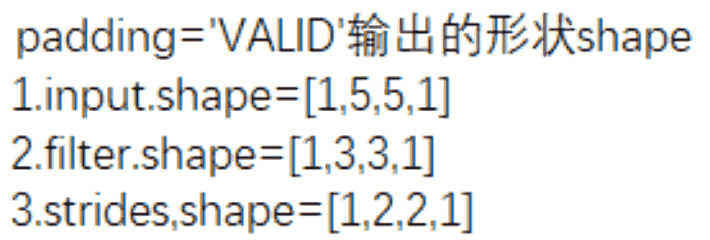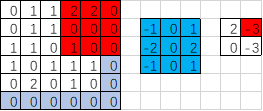Tensorflow之CNN卷积层池化层padding规则
padding的规则
· padding=‘VALID’时,输出的宽度和高度的计算公式(下图gif为例)


输出宽度:output_width = (in_width-filter_width+1)/strides_width =(5-3+1)/2=1.5【向上取整=2】
输出高度:output_height = (in_height-filter_height+1)/strides_height =(5-3+1)/2=1.5【向上取整=2】
输出的形状[1,2,2,1]

import tensorflow as tf
image = [0,1.0,1,2,2,0,1,1,0,0,1,1,0,1,0,1,0,1,1,1,0,2,0,1,0]
input = tf.Variable(tf.constant(image,shape=[1,5,5,1])) ##1通道输入
fil1 = [-1.0,0,1,-2,0,2,-1,0,1]
filter = tf.Variable(tf.constant(fil1,shape=[3,3,1,1])) ##1个卷积核对应1个featuremap输出 op = tf.nn.conv2d(input,filter,strides=[1,2,2,1],padding='VALID') ##步长2,VALID不补0操作 init = tf.global_variables_initializer() with tf.Session() as sess:
sess.run(init)
# print('input:\n', sess.run(input))
# print('filter:\n', sess.run(filter))
print('op:\n',sess.run(op)) ##输出结果
'''
[[[[ 2.]
[-1.]] [[-1.]
[ 0.]]]]
'''
VALID步长2
如果strides=[1,3,3,1]的情况又是如何呢?
输出宽度:output_width = (in_width-filter_width+1)/strides_width =(5-3+1)/3=1
输出高度:output_height = (in_height-filter_height+1)/strides_height =(5-3+1)/3=1
输出的形状[1,1,1,1],因此输出的结果只有一个

import tensorflow as tf
image = [0,1.0,1,2,2,0,1,1,0,0,1,1,0,1,0,1,0,1,1,1,0,2,0,1,0]
input = tf.Variable(tf.constant(image,shape=[1,5,5,1])) ##1通道输入
fil1 = [-1.0,0,1,-2,0,2,-1,0,1]
filter = tf.Variable(tf.constant(fil1,shape=[3,3,1,1])) ##1个卷积核对应1个featuremap输出 op = tf.nn.conv2d(input,filter,strides=[1,3,3,1],padding='VALID') ##步长2,VALID不补0操作 init = tf.global_variables_initializer() with tf.Session() as sess:
sess.run(init)
# print('input:\n', sess.run(input))
# print('filter:\n', sess.run(filter))
print('op:\n',sess.run(op)) ##输出结果
'''
op:
[[[[ 2.]]]]
'''
VALID步长3
padding=‘SAME’时,输出的宽度和高度的计算公式
输出宽度:output_width = in_width/strides_width=5/2=2.5【向上取整3】
输出高度:output_height = in_height/strides_height=5/2=2.5【向上取整3】
则输出的形状:[1,3,3,1]
那么padding补0的规则又是如何的呢?【先确定输出形状,再计算补多少0】
pad_width = max((out_width-1)*strides_width+filter_width-in_width,0)=max((3-1)*2+3-5,0)=2
pad_height = max((out_height-1)*strides_height+filter_height-in_height,0)=max((3-1)*2+3-5,0)=2
pad_top = pad_height/2=1
pad_bottom = pad_height-pad_top=1
pad_left = pad_width/2=1
pad_right = pad_width-pad_left=1

import tensorflow as tf
image = [0,1.0,1,2,2,0,1,1,0,0,1,1,0,1,0,1,0,1,1,1,0,2,0,1,0]
input = tf.Variable(tf.constant(image,shape=[1,5,5,1])) ##1通道输入
fil1 = [-1.0,0,1,-2,0,2,-1,0,1]
filter = tf.Variable(tf.constant(fil1,shape=[3,3,1,1])) ##1个卷积核对应1个featuremap输出 op = tf.nn.conv2d(input,filter,strides=[1,2,2,1],padding='SAME') ##步长2,VALID不补0操作 init = tf.global_variables_initializer() with tf.Session() as sess:
sess.run(init)
# print('input:\n', sess.run(input))
# print('filter:\n', sess.run(filter))
print('op:\n',sess.run(op)) ##输出结果
'''
op:
[[[[ 3.]
[ 1.]
[-4.]] [[ 3.]
[ 0.]
[-3.]] [[ 4.]
[-1.]
[-3.]]]]
'''
SAME步长2
如果步长为3呢?补0的规则又如何?
输出宽度:output_width = in_width/strides_width=5/3=2
输出高度:output_height = in_height/strides_height=5/3=2
则输出的形状:[1,2,2,1]
那么padding补0的规则又是如何的呢?【先确定输出形状,再计算补多少0】
pad_width = max((out_width-1)*strides_width+filter_width-in_width,0)=max((2-1)*3+3-5,0)=1
pad_height = max((out_height-1)*strides_height+filter_height-in_height,0)=max((2-1)*3+3-5,0)=1
pad_top = pad_height/2=0【向下取整】
pad_bottom = pad_height-pad_top=1
pad_left = pad_width/2=0【向下取整】
pad_right = pad_width-pad_left=1

import tensorflow as tf
print(3/2)
image = [0,1.0,1,2,2,0,1,1,0,0,1,1,0,1,0,1,0,1,1,1,0,2,0,1,0]
input = tf.Variable(tf.constant(image,shape=[1,5,5,1])) ##1通道输入
fil1 = [-1.0,0,1,-2,0,2,-1,0,1]
filter = tf.Variable(tf.constant(fil1,shape=[3,3,1,1])) ##1个卷积核对应1个featuremap输出 op = tf.nn.conv2d(input,filter,strides=[1,3,3,1],padding='SAME') ##步长2,VALID不补0操作 init = tf.global_variables_initializer() with tf.Session() as sess:
sess.run(init)
# print('input:\n', sess.run(input))
# print('filter:\n', sess.run(filter))
print('op:\n',sess.run(op)) ##输出结果
'''
op:
[[[[ 2.]
[-3.]] [[ 0.]
[-3.]]]]
'''
SAME步长3
Tensorflow之CNN卷积层池化层padding规则的更多相关文章
- tensorflow中的卷积和池化层(一)
在官方tutorial的帮助下,我们已经使用了最简单的CNN用于Mnist的问题,而其实在这个过程中,主要的问题在于如何设置CNN网络,这和Caffe等框架的原理是一样的,但是tf的设置似乎更加简洁. ...
- tensorflow的卷积和池化层(二):记实践之cifar10
在tensorflow中的卷积和池化层(一)和各种卷积类型Convolution这两篇博客中,主要讲解了卷积神经网络的核心层,同时也结合当下流行的Caffe和tf框架做了介绍,本篇博客将接着tenso ...
- CNN中卷积层 池化层反向传播
参考:https://blog.csdn.net/kyang624823/article/details/78633897 卷积层 池化层反向传播: 1,CNN的前向传播 a)对于卷积层,卷积核与输入 ...
- tensorflow 1.0 学习:池化层(pooling)和全连接层(dense)
池化层定义在 tensorflow/python/layers/pooling.py. 有最大值池化和均值池化. 1.tf.layers.max_pooling2d max_pooling2d( in ...
- CNN中的池化层的理解和实例
池化操作是利用一个矩阵窗口在输入张量上进行扫描,并且每个窗口中的值通过取最大.取平均或其它的一些操作来减少元素个数.池化窗口由ksize来指定,根据strides的长度来决定移动步长.如果stride ...
- 『TensorFlow』卷积层、池化层详解
一.前向计算和反向传播数学过程讲解
- 第十三节,使用带有全局平均池化层的CNN对CIFAR10数据集分类
这里使用的数据集仍然是CIFAR-10,由于之前写过一篇使用AlexNet对CIFAR数据集进行分类的文章,已经详细介绍了这个数据集,当时我们是直接把这些图片的数据文件下载下来,然后使用pickle进 ...
- tensorflow CNN 卷积神经网络中的卷积层和池化层的代码和效果图
tensorflow CNN 卷积神经网络中的卷积层和池化层的代码和效果图 因为很多 demo 都比较复杂,专门抽出这两个函数,写的 demo. 更多教程:http://www.tensorflown ...
- CNN卷积神经网络的卷积层、池化层的输出维度计算公式
卷积层Conv的输入:高为h.宽为w,卷积核的长宽均为kernel,填充为pad,步长为Stride(长宽可不同,分别计算即可),则卷积层的输出维度为: 其中上开下闭开中括号表示向下取整. MaxPo ...
随机推荐
- 使用Python发送企业微信消息
准备工作: 到企业微信官网,注册一个企业:登录企业微信后台,创建一个“自建”应用, 获取企业ID.agentid.secret这3个必要的参数:在企业微信的通讯录中,创建多个测试账号:在手机端安装“企 ...
- linux extglob模式 和rm反选,除了某个文件外的其他文件全部删除的命令
1.extglob模式开启之后Shell可以另外识别出5个模式匹配操作符,能使文件匹配更加方便. 不然不识别 #开启命令: shopt -s extglob #关闭命令: shopt -u extgl ...
- GUI学习之三十一—QLabel学习总结
前面所有的控件都是归于输入控件的,下面我们要总结下展示控件的用法.首先要将的就是最常用的QLabel. 一.描述 标签控件(QLabel)提供了文本或图像显示的功能,可以用来显示 普通文本 数字 富 ...
- python time、datetime模块
时间的三种格式:1)时间戳 2)格式化的时间字符串 3)元组(struct_time):time.struct_time(tm_year=1970, tm_mon=5, tm_mday=23, tm_ ...
- Halcon WPF C#采集图像区域灰度值
源码下载地址:https://github.com/lizhiqiang0204/ImageGray.git Halcon代码如下: *读取图片,转换成灰度图片 read_image (Image1, ...
- FCC 成都社区·前端周刊 第 9 期
1. Node.js 10 将带来什么? Node.js 10 的第一个版本将于本周二(4 月 24 日)发布,并将在 10 月份推出 LTS 版本,将带来哪些更新? N-API,持续 HTTP/2 ...
- cron常用表达式
原创转载请注明出处:https://www.cnblogs.com/agilestyle/p/11905247.html 推荐一个cron表达式生成的网站:https://www.freeformat ...
- css3 宽度百分比减去固定宽度 无效问题
一定要注意中间横线的间距才有效果 正确 width: calc(50% - 10px); 错误 width:calc(50%-10px);
- LeetCode--079--单词搜索(python)
给定一个二维网格和一个单词,找出该单词是否存在于网格中. 单词必须按照字母顺序,通过相邻的单元格内的字母构成,其中“相邻”单元格是那些水平相邻或垂直相邻的单元格.同一个单元格内的字母不允许被重复使用. ...
- Java——JDK1.5新增强的for循环
<1>JDK1.5新增的for循环对于遍历array或collection非常便利. <2>缺陷: 数组:不能方便地访问下标值. 集合:与使用Int ...
